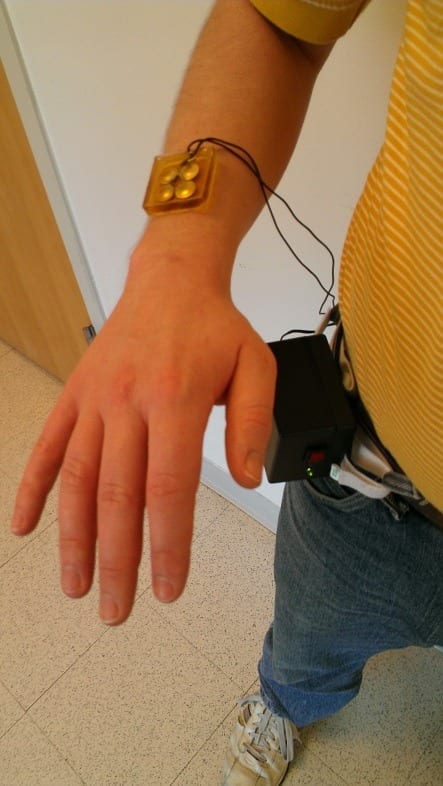
TAU researcher develops surprising tool to measure our changing climate
The ionosphere, one of the regions of the upper atmosphere, plays an important role in global communications. Ionized by solar radiation, this electricity-rich region is used for the transmission of long wave communications, such as radio waves. Now Prof. Colin Price of Tel Aviv University‘s Department of Geophysical, Atmospheric and Planetary Sciences, working alongside PhD candidate Israel Silber, has discovered that the radio waves reflecting back to Earth from the ionosphere offer valuable news on climate change as well.
Their research shows that the strength of radio signals on the ground is a reliable indicator of temperature change above. Prof. Price and his team used simple radio antennae on the ground to measure radio waves broadcast by navigational transmitters around the globe, then compared information on the strength of these radio signals with data on temperature fluctuations in the upper atmosphere. They discovered that climate change in the upper atmosphere — caused by an abundance of greenhouse gases — may lead to a greater absorption of radio waves. Weaker signals could therefore be indicative of greater climate change.
Detailed in the Journal of Geophysical Research, this simple, cost-effective measurement can be a valuable contribution to the ongoing effort to track climate change, says Prof. Price, adding to measurements of ground and lower atmospheric temperatures to create a more holistic picture.
Global warming, upper atmospheric cooling
On the Earth’s surface and in the lower atmosphere, an increase of greenhouse gases has a warming effect, the gases acting as a “blanket” and keeping heat from escaping from the Earth into space. But these gases, including carbon dioxide, are increasing in the upper atmosphere as well, where they have a cooling effect.
When cooled, the ionosphere contracts and descends into the atmosphere to where air is denser — leading to a higher absorption of radio waves, Prof. Price explains. By examining satellite-gathered data on the temperature in the upper atmosphere and comparing results to measurements of radio wave amplitudes collected on the ground, the researchers were able to uncover a clear correlation, consistent over time. As the upper atmosphere gets colder, radio signals lose their strength.
While the sun is certainly the driving force behind changes in temperature in this region, it accounts for only 60 to 70 percent of temperature variations, says Prof. Price. The remaining variability could not be systematically measured until now. By adding measurements of radio waves taken on the ground to solar radiation estimates, researchers can now explain approximately 95 percent of temperature changes in the upper atmosphere.
The Latest Bing News on:
Climate Change
- The Power of Us: Climate change has disproportionately impacted these vulnerable US communities, experts sayon April 27, 2024 at 6:09 am
The disproportionate impacts of climate change on the poorest communities are already affecting pockets of the U.S.
- Is Russia ready for climate change? Mass floods expose lack of adaptation, campaigners sayon April 26, 2024 at 11:00 pm
Mass floods in Russia have thrown a spotlight on the country’s approach to managing the increasing risks it faces from climate change.
The Latest Google Headlines on:
Climate Change
[google_news title=”” keyword=”Climate Change” num_posts=”10″ blurb_length=”0″ show_thumb=”left”]
The Latest Bing News on:
Measure our changing climate
- Beavers are helping fight climate change, satellite data showson April 27, 2024 at 8:00 am
As global warming intensifies droughts, floods and wildfires around the world, scientists in western United States are turning to beavers to help reverse some of the damage.
- Lawmakers hope to use this emerging climate science to charge oil companies for disasterson April 27, 2024 at 6:00 am
A fast-emerging field of climate research is helping scientists pinpoint just how many dollars from a natural disaster can be tied to the historic emissions of individual oil companies — analysis that ...
- Zoogeochemists measure how animals change the chemistry of their environmentson April 26, 2024 at 5:52 pm
Ecologists are blazing trails in a new field they’ve dubbed zoogeochemistry, which explores how animals influence nutrient cycling and carbon entering and exiting their ecosystems. Through everyday ...
- Groups say Mills’ veto of energy-labor bill will weaken state efforts to tackle climate changeon April 26, 2024 at 1:43 pm
Gov. Janet Mills on Friday vetoed a bill that union and climate leaders argued would ensure clean energy projects on state land aren’t disrupted by labor disputes. The Democratic governor, however, ...
- Scientists use 'leaf glow' to understand changing climateon April 25, 2024 at 12:58 pm
New University of Minnesota research suggests "leaf glow" provides vital information on vegetation dynamics in Arctic and boreal ecosystems like Minnesota's forests and wetlands, which are among the ...
- Summer Reading Book Looks at Climate Change Through the Lens of 60 Womenon April 25, 2024 at 10:12 am
Each October, there is an open nomination process for book titles. This year, there were more than 50 suggested books from staff, faculty, students and alumni. The 11-member search committee whittled ...
- How NASA monitors climate change on Earth from the ISSon April 25, 2024 at 6:00 am
International Space Station (ISS) missions gather crucial climate data, aiding global environmental planning and resilience.
- Climate Change Poses a Child Labor ‘Threat Multiplier’on April 24, 2024 at 3:58 am
Global warming is exacerbating the conditions that lead to the workplace exploitation of minors. Now there’s a new way to measure it.
- Your most pressing climate questionson April 23, 2024 at 12:11 pm
Glaciers are shrinking, coral reefs are in crisis and last year was the hottest on record. Atmospheric concentrations of carbon dioxide, the main greenhouse gas, have passed a dangerous new threshold ...
- Cornell University is measuring animal-borne gases. Here's how it can help the climateon April 22, 2024 at 12:41 pm
Cornell University’s College of Agriculture and Life Sciences recently celebrated the opening of its latest leap toward creating environmental sustainability for the dairy industry: a suite of ...
The Latest Google Headlines on:
Measure our changing climate
[google_news title=”” keyword=”measure our changing climate” num_posts=”10″ blurb_length=”0″ show_thumb=”left”]










